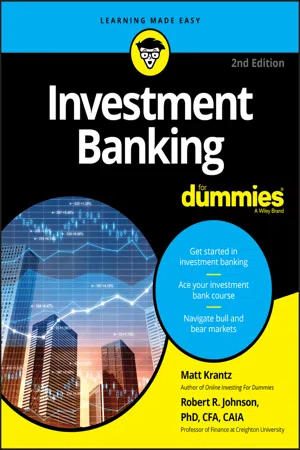Economics
Investment Banks
Investment banks are financial institutions that provide a range of services to corporations, governments, and other entities. These services typically include underwriting, mergers and acquisitions, securities trading, and asset management. Investment banks play a crucial role in facilitating the flow of capital in the economy and are key players in the financial markets.
Written by Perlego with AI-assistance
Related key terms
7 Key excerpts on "Investment Banks"
- eBook - ePub
- Matthew Krantz, Robert R. Johnson(Authors)
- 2020(Publication Date)
- For Dummies(Publisher)
One of the trickiest parts of understanding investment banking is that it’s typically a menu of financial services. Some investment banking operations may offer some services, but not others.The services offered by Investment Banks typically fall into one of a few buckets. One of the best ways to understand Investment Banks is to examine all the functions that some of the biggest Investment Banks perform. For example, Morgan Stanley, one of the world’s largest Investment Banks, has its hands in several key business areas, including the following:- Capital raising: This part of the investment banking function helps companies and organizations generate money from investors. This is typically done by selling shares of stock or debt.
- Financial advisory: In this role, the investment banking operation is hired to help a company or government make decisions on managing their financial resources. Advice may pertain to whether to buy another company or sell off part of the business. A common business decision tackled by this type of investment banking is whether to acquire another company or divest of a current product line. This is called mergers and acquisitions (M&A) advisory.
- Corporate lending: Investment Banks typically help companies and other large borrowers sell securities to raise money. But large Investment Banks are also frequently involved in extending loans to their customers, often short-term loans (called bridge loans ) to tide a company over while another transaction is in the works.
- Sales and trading: Investment bankers are a creative and innovative lot, in the business of constructing financial instruments to be bought and sold. It’s natural for investment bankers to also buy and sell stocks and other financial instruments either on the behalf of their clients or using their own money.
- Brokerage services: Some investment banking operations include brokerage services where they may hold clients’ assets or help them conduct trades.
-
Research:
- Saíd El-Naggar(Author)
- 1994(Publication Date)
- INTERNATIONAL MONETARY FUND(Publisher)
The supply of equities in many countries has been limited by the reluctance of owners of private companies to dilute their ownership and control by issuing stock to the public and to comply with requirements to disclose information about their operations. The availability of less expensive debt finance has also discouraged equity issues. The absence of an appropriate legal, regulatory and tax framework has further inhibited the development of capital markets. Double taxation on dividends and capital gains, and the tax-free status of government securities has lessened the appeal of private equity and bonds. Investor confidence has been further undermined by the lax enforcement of corporate income taxes as closely held corporations are able to avoid taxes by showing depressed profits. The lack of timely and accurate financial information has often resulted in speculative trading that has further hurt investor demand for securities in developing countries.The efficient functioning of financial markets also depends on institutions that lend and borrow little on their own account; Investment Banks, securities brokers and credit rating agencies.Investment Banks . Investment Banks are important constituents of securities markets; they are intermediaries for locating and collecting funds for their clients so they can finance new investment products. They are major players in the development of securities offerings. In addition, they arrange private placements, provide funds management, and perform corporate advisory and portfolio management services. Investment Banks have yet to play a major role in Arab countries, which are still in the process of developing their nascent capital markets.Investment bankers bring new securities to the market by purchasing whole issues of securities from corporate issuers or from public bodies and distributing them to institutional and individual investors. By making a firm commitment to purchase the securities from the company, the investment banker insures any risk associated with a new issue. This service, known as underwriting, permits government and corporate entities to broaden their sources of long-term financing beyond the banking system. Underwriting is critical to the development of emerging markets where corporate or public entities are reluctant to raise equity capital without the guarantee provided by this service. Investment Banks are also market makers in secondary markets.Corporate advisory services are a growing business for Investment Banks in emerging markets. The private sector in many developing countries has been accustomed to functioning in heavily controlled and protected market environments that have provided inadequate preparation for businesses to respond to market signals. Investment Banks can play an important part in advising businesses on how to compete in a more open and international economy. However, they also have a key advisory role in relation to project financing, i.e., identifying project risks, attracting technical partners, identifying and selecting sources of finance, and structuring the financial package. While banks, long-term financing institutions, and institutional investors provide financing, Investment Banks arrange financing and can play a useful role in organizing loan syndications for large amounts of financing.- eBook - ePub
Finance in Asia
Institutions, Regulation and Policy
- Qiao Liu, Paul Lejot, Douglas W. Arner(Authors)
- 2013(Publication Date)
- Routledge(Publisher)
users of those products, regardless of the purpose for which they may be employed. We see the expansion of investment banking as central to the financialization trend from the late twentieth century.Our analysis follows the most profound changes in the investment banking landscape since the late 1920s. Although this chapter charts the performance of well-known banks, it is more concerned with the process and functions of investment banking than any single organization or national group – indeed, two of the banks that feature in Chapter 10 ’s M&A case study no longer exist as independent entities. Lehman Brothers entered bankruptcy proceedings in September 2008 while Merrill Lynch simultaneously sold itself to Bank of America to escape insolvency. Large parts of Lehman’s operations in the US and elsewhere were acquired respectively by Barclays Capital and Nomura.The credit collapse intensified in the final quarter of 2008 into a pervasive withdrawal of liquidity from banks of all types and in many countries. Access to wholesale funding is oxygen to all but the most conservative savings banks but was especially vital for the prominent, highly leveraged US Investment Banks, and in a matter of weeks they each lost their freewheeling independence, either collapsing into insolvency (Lehman Brothers), merging into deposit-rich banks (Merrill Lynch), or adopting a more conservative and closely supervised business model and raising capital from new strategic shareholders (Goldman Sachs and Morgan Stanley). - David P. Stowell(Author)
- 2012(Publication Date)
- Academic Press(Publisher)
Table 1.5 for a sampling of banks that compete in each of these areas.Table 1.5 Investment Banking FirmsInvestment Banking Businesses
Although each investment bank takes a somewhat different approach, the basic businesses of most large Investment Banks consist of (a) an investment banking business managed by the Investment Banking Division that principally focuses on capital raising and mergers and acquisitions (M&A) transactions for corporate clients and capital raising for government clients; (b) a sales and trading business managed by the Trading Division that provides investing, intermediating, and risk-management services to institutional investor clients, research, and also participates in nonclient-related investing activities; and (c) an asset management business managed by the Asset Management Division that is responsible for managing money for individual and institutional investing clients (see Exhibit 1.2 ).Exhibit 1.2 Principal Businesses of Investment BanksInvestment Banking Business• Arranges financings for corporations and governments • Debt • Equity • Convertibles • Advises on mergers and acquisitions (M&A) transactionsTrading Business• Client Trading • Sells and trades securities and other financial assets as an intermediary on behalf of investing clients- eBook - ePub
- Geoffrey Jones(Author)
- 2012(Publication Date)
- Routledge(Publisher)
5 Multinational enterprises are simply collections of firms in different countries under common ownership. Transactions between them thus become internal rather than market transactions. In the case of Investment Banks, our objective is to demonstrate that the extension of the scope and geographical spread of their activities has been a response to the need to compete in terms of price, speed and quality of service. Internalization has been the means by which they have improved their competitiveness in all three areas.What Investment Banks do
The range of activities of the twenty-one large Investment Banks in the SEC study differ widely. However, there are core activities that all are involved in and which clearly distinguish them from commercial banks. Investment banking involves assessing market risk, finding investors and minimizing the time for which assets are held on a balance sheet as distinct from traded. Deposit or commercial banking on the other hand involves seeking deposits, assessing credit risk and using deposits to make loans to build up a balance sheet. In investment banking, the objective is to maximize asset turnover and control market risk, while in commercial banking the objective is to maximize balance sheet size subject to controlling the level of credit risk. Given the difference in asset turnover rates, it is not surprising that commercial banks have for many decades been highly capitalized public companies while securities firms have historically been private partnerships with limited capital. One of the questions we shall examine is why, in the 1960s and 1970s, securities houses have experienced the need to raise additional capital either by dissolving their partnership status or by accepting an investment from an outside firm.The major activity of Investment Banks is their involvement in either primary or secondary securities markets or in both.6 These remain roles distinct from those of commercial banks (qua commercial banks) and are the ones that we shall be examining in this paper. Primary market activity involves arranging the flotation of new securities issues in the primary market for corporate, sovereign and public sector customers (henceforth called simply corporates). Two types of new securities issue are arranged. The Initial Public Offering (IPO) and the secondary offering, i.e. one which is simply adding to the existing stock of securities. Secondary market - eBook - ePub
International Corporate Finance (RLE International Business)
Markets, Transactions and Financial Management
- Harvey Poniachek(Author)
- 2013(Publication Date)
- Routledge(Publisher)
Commercial banks typically accept retail deposits or bid for deposits in the wholesale markets. Their assets are primarily loans of different types. Investment Banks have a different function in that they typically arrange issues of securities for clients and function as advisors to them on a wide range of financial matters. In the United States, Japan, and some other countries, a sharp distinction has historically been drawn between these two types of institutions. In the United States the Glass-Steagall Act of 1933 separated the business of underwriting and selling securities from the taking of deposits subject to withdrawal on request. The Act followed the banking crisis of the early 1930s and was part of a considerable increase in United States regulation of the banking sector. It was passed in response to perceived abuses, including the insurance of bad loans and unsound securities, arising from the mixing of commercial and investment banking functions.The participation of private institutions in international finance must be viewed in dynamic terms for the international financial markets have been subject to rapid change in recent years. Technological advances and innovations in financial instruments have provided an impetus to international financial market growth (see Chapter 2 ). As the markets have evolved, so have the nature and structures of the institutions that participate in them. The relationship is a simultaneous one, however, for the institutions are the market makers and the primary source of innovation.The Internationalization Phase
During the 1970s strong forces encouraged institutional participation in the international markets. In the sphere of commercial bank lending the forces were so strong that they led to a major thrust toward the internationalization of lending.In the immediate post-World War II period up to the end of the 1960s the movement of capital internationally was hampered by the existence of exchange controls that had been introduced to defend the parities of currencies in the fixed-parity system. The international financial system was dominated, as noted above, by the flow of official capital. Private markets provided relatively modest amounts of international financing. Most of it was either in the form of trade finance or domestic currency finance for companies that were extending their operations abroad. - David P. Stowell(Author)
- 2010(Publication Date)
- Academic Press(Publisher)
club LBOs, where an investment bank will co-invest with these clients if the acquisition amount is in excess of the capacity the private equity firms are able to provide. In this case, Investment Banks claim that they are facilitating private equity client investment objectives, instead of competing against them.Other potential conflicts of interest arise sometimes when a bank is retained to advise a corporate client that is the target of a potential hostile acquirer. For example, in 2006, Goldman Sachs was acting as an M&A advisor to BAA (the owner and operator of seven British airports) after the company became a target of a hostile takeover attempt. The company was surprised when Goldman Sachs’s Principal Investments team indicated their interest to acquire BAA if this prevented the company from falling into the hands of a hostile acquirer. In this case, the company was concerned because, after hiring the firm to protect them from acquirers, Goldman Sachs became a potential acquirer. Goldman, on the other hand, felt that they were acting as a potential “white knight” to preempt a hostile acquisition with a friendly acquisition offer. The result was that BAA fired Goldman Sachs as their M&A advisor, and the original hostile acquirer outbid Goldman Sachs by acquiring $1.9 billion of BAA stock in the open market. Goldman Sachs was criticized by the press in the United Kingdom, which led to their CEO’s announcement that the firm needed to be more careful to avoid potential conflict of interest situations in the future.Other Investment Banking Functions
The other activities conducted by an investment bank are characterized as service areas designed to facilitate revenue production in the previously described businesses. Included among these service areas are Finance, Operations, Compliance, HR, Legal, Building and Security Management, and Technology. Each of these areas is important for the successful operation of an investment bank. The Operations and Finance areas are summarized in the following sections.
Index pages curate the most relevant extracts from our library of academic textbooks. They’ve been created using an in-house natural language model (NLM), each adding context and meaning to key research topics.






